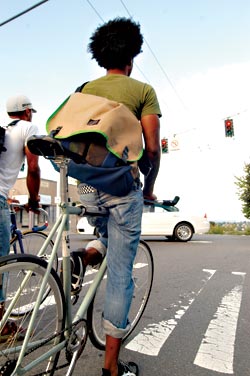Drivers hate cyclists because, it seems, they’re always flagrantly disobeying the law, running red lights and stop signs, but most of all because in doing so they slow down traffic and force cars to brake and swerve when they shouldn’t have to. Why doesn’t someone write them a ticket?
Cyclists hate cars because drivers refuse to share the road, cars are loud and make smelly exhaust that no one wants to breathe, but most of all because they are large moving hunks of metal and their drivers couldn’t seem to care less about their impact on a frail human body perched atop a lightweight bicycle.
A lot of this is simply attitude. Auto drivers ought to realize that having more bikes on the road benefits them: It reduces the number of cars as well as the demand for gasoline. Cyclists ought to understand that fostering a respect for the rules of the road helps create a less threatening environment for them as well.
We could all get along if we all took some simple steps.
Getting along with cyclists
Sure, bikes can be a pain to deal with in traffic. They can slow you down at inopportune times, and inevitably, there are the bad apples who force you to lay on your brakes and your horn.
But it’s important to understand that the only reason you notice these cyclists is because they’re breaking the law and creating a road hazard. The best cyclists—the ones who obey the law, stay out of your way, and generally avoid creating problems—are exactly the people you’re not likely to notice. And believe it or not, they are in the majority.
Even those cyclists, however, need your cooperation, because inevitably, they do have to interact with you. Here are some suggestions:
• Remember that bicycles, by state law, are vehicles just like cars—only slower moving. Accord them the same kind of respect that other slow-moving vehicles enjoy.
• When possible, pass bicycles with a minimum of five feet between your right fender and the cyclist’s left legs. That will give both of you a feeling of safety.
• Don’t honk. Bicyclists, unless they’re illegally wearing headphones, can always hear the cars behind them, so even a courteous honk to let them know you’re there is unnecessary. At the same time, honking can be very unnerving for a cyclist and can produce the kind of swerves you don’t want to deal with.
• If passing a bicycle immediately is impossible because the lane is too narrow and oncoming traffic too heavy, simply be patient—slow down and maintain the same speed as the cyclist. Your chance to pass will come along sooner than you think, especially since passing a bike is usually quick and easy.
• If you’re in traffic and can see that cars in the oncoming lane are stuck behind a cyclist, move to the right to give them all more passing room.
• Remember that bikes, particularly on downhill slopes, can move almost as fast as a car, and when they’re in the 20–30 mph range, they need to move out more into the middle of the lane for an increased margin of safety. Concede them that space, and be patient about passing them.
• Be especially conscious about turning into bikes. The most common kind of bike-vehicle collisions are those that occur when cars turn directly in front of an onrushing cyclist. Be aware of the presence of bikes, both ahead of and behind you, before you make any turns. If need be, wait for the cyclist to go by you before turning. Trying to dart in front of them is a quick avenue to a collision and a claim against your insurance policy.
• The one exception for the bicycles-as-vehicles rule comes when cyclists use designated pathways like the Burke-Gilman Trail. In that situation, according to state law, they enjoy the same status as the pedestrians with whom they share these paths. So when you come to a crossing with such a path, treat cyclists exactly as you would a pedestrian: Stop and let them cross.
Getting along with autos
When you’re out on the road, it never hurts to remember that you play a role in how automobile drivers perceive all bicyclists, and that, in the long run, affects your own commute. The more drivers there are who perceive cyclists as cooperative co-users of the road, the less likely you are to be riding in a hostile environment. Call it enlightened self-interest.
Sure, there are plenty of rude and unpleasant drivers out there with an attitude about people on bikes. What will change that, however, is increasing the numbers of cyclists who demonstrate that, with a little patience, cars and bikes can get along just fine.
Here’s how to make a difference:
• Always ride on the right or within a bike lane when one is present, unless other vehicles (including bikes) or other circumstances (like a suddenly opened door) force you into traffic. But try to be alert and considerate of cars when those circumstances arise. Riding against traffic is monumentally stupid.
• Obey all traffic signals. You are, by law, a vehicle, and can be ticketed for ignoring signals or any of the rules of the road. Of course, there are situations—obscure stop signs in remote spots on the Burke-Gilman trail when no vehicles are in sight, for instance—when complete obedience to the law makes little sense. But for the most part, flouting the rules of the road, especially when cars are present, just perpetuates the image of bicyclists as rule-breaking jerks and raises the general hostility toward bike riders accordingly.
• Ride single file if you’re in a group, unless there’s no traffic around you.
• The safest place on the road to ride is in a straight line about three feet from the edge of the road or curb. This gives you a safety margin in case of an obstruction or the need for a sudden maneuver, and it still gives cars enough room to move around you comfortably in most situations.
• Ride steadily. Nothing makes drivers more nervous than a weaving bicyclist.
• Use hand signals to indicate turns. For right-hand turns, the old left-hand-up signal is now considered obsolete, as it tends to confuse drivers more than it helps; just use your right hand and point where you’re going. And in the event of an obnoxious driver, the middle finger of either hand does not qualify as the signal of a courteous cyclist.
• Use headlights and rear lights at night. Again, this is the law. And besides, riding without a headlight at night is considered an entire category unto itself in the Darwin Awards. A mere blinking rear light doesn’t cut it, either, because oncoming cars and cars pulling out at intersections in front of you still can’t see you.
• In case a driver decides he or she doesn’t want to co-exist with you, wear a helmet. Always. (Back in Montana, the saying among the biking set was that a helmetless rider didn’t have brains worth protecting anyway.)
• Leave the headphones at home. Oh yeah, it’s nice to have tunes on your bike, especially when you’ve created that special “Biking” playlist on your iPod, but it’s against the law, and for good reason: In traffic it’s unsafe. Not to mention dumb. Cyclists need to be able to hear cars behind them to ride safely among them, and even on dedicated bikeways, you need to hear other riders around you as well. About the only excusable time to ride with headphones is late at night or midwinter on the Burke-Gilman, when there’s no one around.







